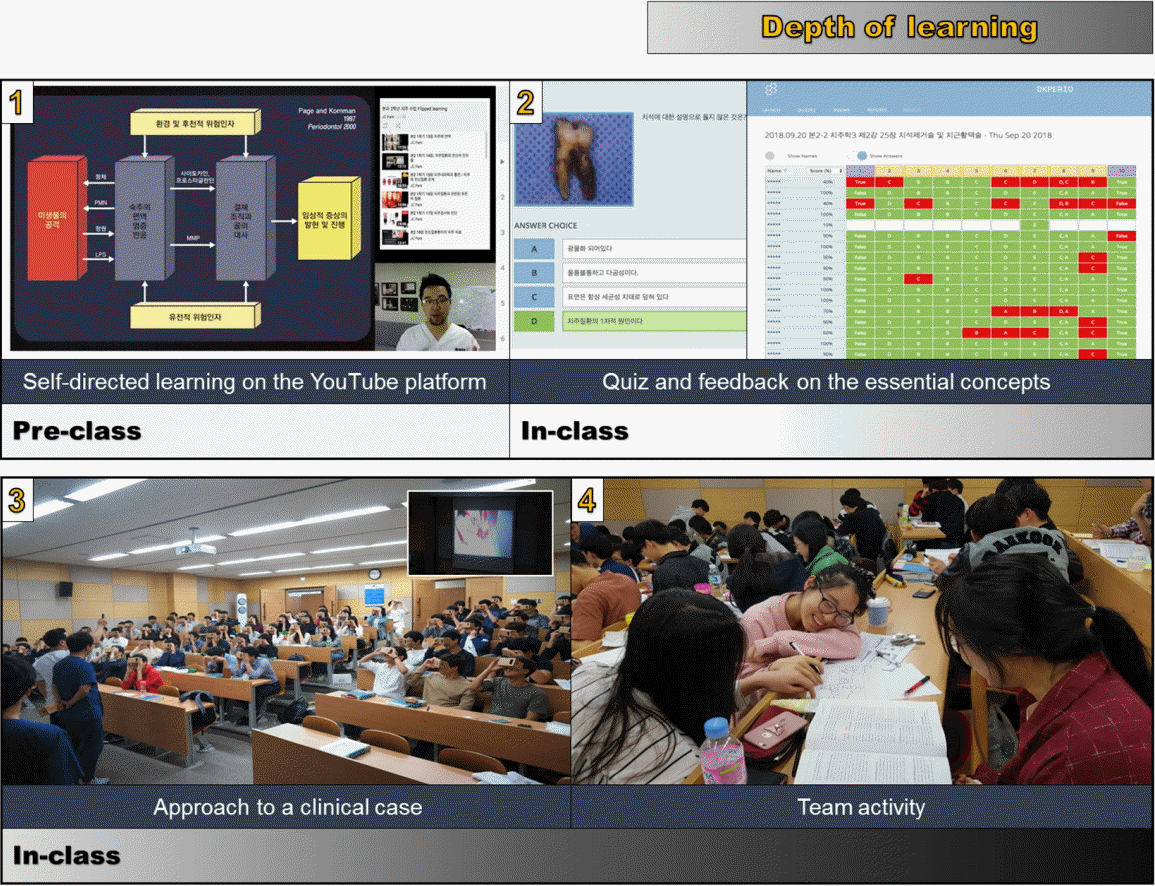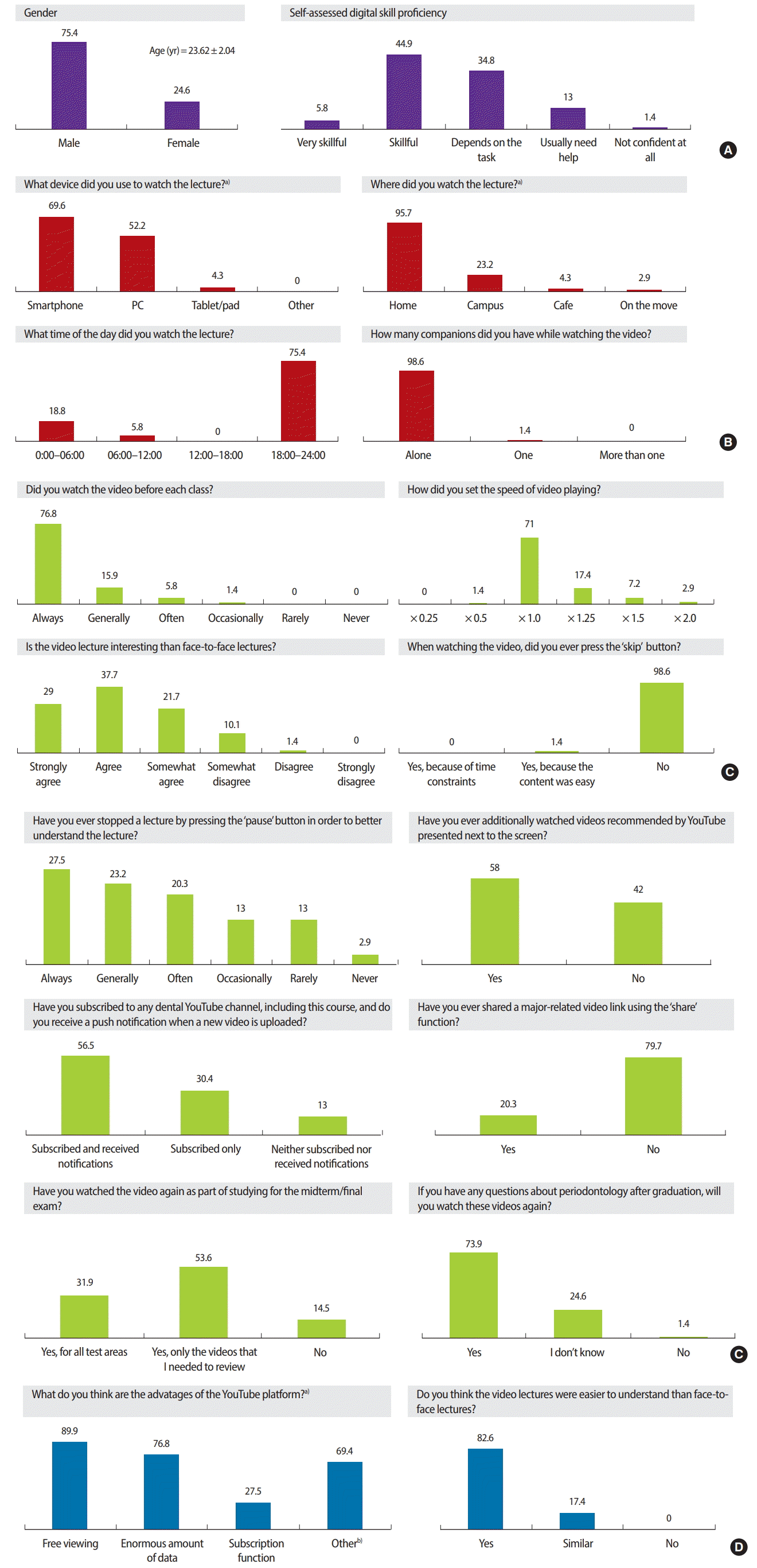Short Review of the Flipped Classroom Approach Jy Leung Sm Kumta Y Jin Al Yung
This commodity has been cited by other manufactures in ScienceCentral.
Abstract
Purpose
The aim of this study was to confirm the applicability of YouTube as a delivery platform of lecture videos for dental students and to assess their learning attitudes towards the flipped classroom model.
Methods
Learning experiences subsequently using the YouTube platform to deliver preliminary video lectures in a flipped classroom were assessed by 69 second-year students (52 males, 17 females) at Dankook Academy Higher of Dentistry, Korea, who attended periodontology lectures during ii consecutive semesters of the 2016 academic year. The instructor uploaded the lecture videos to YouTube before each class. At the cease of the second semester, the students were surveyed using a questionnaire devised by the authors.
Results
Of the students, 53 (76.8%) always watched the lecture earlier the class, 48 (69.six%) used their smartphones, and 66 (95.vii%) stated that they watched the lectures at habitation. The majority of the students replied that the video lectures were easier to understand than face to confront lectures (82.six%) and that they would like to view the videos again after graduation (73.9%).
Determination
Our results indicate that YouTube is an applicable platform to deliver video lectures and to expose students to increased learning opportunities.
Introduction
Dental education has undergone unprecedented changes to more directly involve students in learning by focusing on critical thinking, trouble-solving skills, and student-centered learning [i]. These innovations became possible due to refinements in information and communication technology and the increased prevalence of e-learning or online learning platforms [ii]. One result has been the emergence of the 'flipped classroom' model as an culling to conventional one-to-many lecture-based instruction. The flipped classroom is a teaching method that promotes the learning of basic concepts through pre-learning and concentrates on in-depth learning activities in form through bodily problem-solving and clinical exposure. It is a blazon of composite learning in which in-course learning is integrated with online learning experiences, and students watch pre-recorded lecture videos prior to attention the form [three]. It is critical to provide a flexible environment that is free from time and space constraints to operate a flipped classroom successfully [four]. With this background, we aimed to confirm the applicability of YouTube as a delivery platform of micro-lecture videos to provide the flexible learning environment that is necessary for the flipped classroom.
Case presentation
Ethics statement
This study was approved by the Institutional Review Board of Dankook University Dental Hospital afterward receiving informed consent from the subjects (IRB approving no., DKU DH 2017-10-002).
Case
The participants were 69 second-twelvemonth students of Dankook Academy College of Dentistry who attended a clinical periodontology form (52 males, 17 females). The periodontology course ran from March ii to December 16, 2016. This course contained one-hour weekly sessions, comprising a total of fourteen hours. The teacher recorded the lecture videos using the Screencast application, which records the content of the presentations and the comments of the lecturer in existent-time (Camtasia; TechSmith Corp., Okemos, MI, USA). The lecture videos were uploaded to YouTube earlier the grade (https://www.youtube.com/jcparkland), as shown in Table one (Supplement ane). On average, the micro-lecture videos did non exceed twenty minutes in consideration of the students' ability to focus. Abstracts of all micro-lectures were also uploaded as PDF files. The links to the You lot-Tube videos and the PDF files were posted together using G Suite for Education (Google, Mountain View, CA, USA). The students completed pre-learning by watching micro-lecture videos on the YouTube platform and reading the PDF abstract before attending grade, and their understanding of the content of the micro-lecture videos was assessed through an in-class quiz related to the pre-learning content. Students' answers to the quiz were shared in real time on the screen using the smartphone application Socrative (http://socrative.com) [5], which is a cloud-based student response system. For topics for which students' understanding was considered to be lacking, immediate feedback was provided by introducing major concepts. Through such a process, students could thoroughly learn the bones concepts that they needed to exist aware of. After checking and complementing the pre-learning process through the quiz and feedback, theoretical perspectives and clinical practise were integrated by linking the content with treatment/surgery fields through Google Cardboard virtual reality (VR) and live surgery broadcasting. This process enhanced the conquering of actual knowledge and promoted motivation to acquire by helping students indirectly experience how the theories they learned were practical in clinical settings. Moreover, afterwards the process, in-depth learning of corresponding topics was promoted through various team-based learning activities, such equally debates, and projects. The details of the pre-grade and in-course process are shown in Fig. 1.
At the end of the second semester, the students were surveyed using the questionnaire devised by the authors. We developed a survey questionnaire to assess the students' learning attitudes and the applicability of YouTube with a rubric, according to which each item was scored on a half-dozen-betoken Likert scale. The questionnaire was adult by the researchers in accelerate and completed by consulting with 2 medical teaching experts. Students responded to the survey after the terminal examination using Google Forms with their smartphones in January 2017. We conducted a descriptive statistical assay, including the frequency and percentage of answers. The raw data of this written report are presented in Supplement ii. The major results were equally follows (Fig. 2).
Beginning, students ordinarily watched the micro-lecture videos using smartphones (69.6%), at their domicile (95.seven%) in the evening after school (75.4%), and they usually watched them alone (98.half-dozen%).
Second, most all students came to grade after watching the micro-lecture videos (92.7%), and they watched them at a speed inside the normal range (range, × 1.0 to × 1.25; 88.4%), without using the skip function (98.half-dozen%), despite concerns. Threescore-seven students (97.1%) reported engaging in supplementary learning practices, such as returning to the previous stage afterward stopping the micro-lecture videos using the break function of YouTube when they encountered difficulty in understanding while watching the lecture. In addition, many students reviewed the related micro-lecture videos to prepare for examinations (85.five%).
Third, 57 students preferred the micro-lecture videos because they perceived them to exist more than helpful for understanding class topics than offline lectures (82.6%), and 73.nine% of the students reported that they intended to watch the videos once more if they go curious well-nigh periodontology later on graduation.
Quaternary, regarding the functions of YouTube, 86.nine% of the students subscribed to a YouTube channel related to their major, and as many as 58.0% of the students additionally watched the related videos that YouTube recommended, as well as the required micro-lecture videos their professor had uploaded. However, only 20.iii% of the students reported having shared a video link with others.
5th, students stated that the YouTube platform had the advantage of allowing them to watch an enormous amount of data (76.8%) for free (89.9%), and YouTube functions such as VR content, replay, feedback using comments, subtitles, and live streaming helped their agreement.
Give-and-take
A previous study reported that it was challenging to implement this novel teaching method due to technical difficulties, even though the students were interested and co-operative regarding the flipped classroom in dental colleges [half dozen]. Our study has shown that the preclass lecture videos were well accepted by the students, and the students considered the YouTube platform to be an efficient platform to distribute the lecture videos. Many students thought that the video lectures were ameliorate than face-to-face lectures for agreement the content. The functions of the micro-lecture videos provided on the YouTube platform, such as pause, replay, speed adjustment, and comments, promoted students' understanding by enabling iterative learning and 2-mode feedback. Furthermore, YouTube'southward functions of sharing and exposing students to related videos helped students abound every bit subjects of learning by enabling students to feel more meaningful and personalized learning. Finally, the goal of these video lectures was to introduce the basic concepts of periodontology to the students, only we likewise intended to provide them learning materials suitable for later reuse whenever they wish to refresh their memory [vii]. The majority of students said that they would sentry the videos over again, which is a very inspiring response, suggesting that this modality may be a useful means of standing teaching in the near hereafter. Additionally, since the YouTube dashboard contains suggestions of related videos, the students tin freely peruse those related videos, somewhen allowing them to access more learning materials and possibly cultivate further involvement in certain topics. About of all, it is noteworthy that students watched the micro-lecture videos at their own speed, using the functions of YouTube appropriately, with a sincere attitude, in user-friendly locations at any time they wanted. This fact implies that the YouTube platform could back up the cocky-directed learning of students by providing high accessibility and serving as a tool that is fit for their needs.
Equally such, we propose, based on our experiences, that YouTube is a suitable platform that facilitates cocky-directed learning of students, providing flexible and diverse learning forms for a flipped classroom. However, equally this study involved a unmarried dental school, it should exist kept in mind that perceptions of efficacy may vary according to learners' characteristics. Therefore, it is expected that research on diverse platforms for learners volition continue in guild to build more effective learning environments, and the flipped classroom will eventually be successfully integrated into dental instruction through suitable course design.
Notes
Supplementary material
References
ane. Reynolds PA. Back to the future of dental education: "lock up your libraries if yous like, just in that location is no gate, no lock, no commodities that you lot can prepare upon the liberty of my mind" Virginia Woolf, a room of ane's ain, 1929. Acta Stomatol Croat. 2014; 48:2–5. https://doi.org/10.15644/asc48/one/0.
![]()
2. Tan PL, Hay DB, Whaites E. Implementing e-learning in a radiological science grade in dental teaching: a short-term longitudinal study. J Dent Educ. 2009; 73:1202–1212.
![]()
3. Strayer JF. How learning in an inverted classroom influences cooperation, innovation and chore orientation. Acquire Environ Res. 2012; 15:171–193. https://doi.org/10.1007/s10984-012-9108-4.
![]()
4. Hamdan N, McKnight P, McKnight K, Arfstrom KM; Flipped Learning Network. A review of flipped learning. [identify unknown]. Flipped Learning Network;2013.
5. Rae MG, O'Malley D. Using an online pupil response system, Socrative, to facilitate active learning of physiology past beginning year graduate entry to medicine students: a feasibility study. MedEdPublish. 2017; 2017:2017–2017. https://doi.org/10.15694/mep.2017.000004.
![]()
6. Park SE, Howell Th. Implementation of a flipped classroom educational model in a predoctoral dental course. J Paring Educ. 2015; 79:563–570.
![]()
7. Leung JY, Kumta SM, Jin Y, Yung AL. Short review of the flipped classroom approach. Med Educ. 2014; 48:1127. https://doi.org/ten.1111/medu.12576.
![]()
Fig. i.
Implementation of the flipped classroom.

Fig. 2.
Descriptive statistics of the mail-grade survey items focusing on the learning experience using the YouTube platform. Values are presented as % or mean ± standard departure. (A) Basic information. (B) Pre-learning environment. (C) Lecture viewing: learning mental attitude and sensation. (D) Cess of the YouTube platform. PC, personal computer. a)Multiple selection; b)Sharing, virtual reality content, replay, feedback using comments, subtitles, and live streaming.

Source: https://synapse.koreamed.org/articles/1149101
Post a Comment for "Short Review of the Flipped Classroom Approach Jy Leung Sm Kumta Y Jin Al Yung"